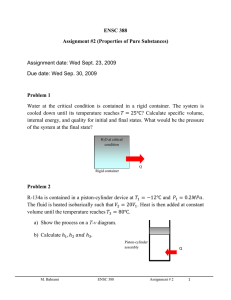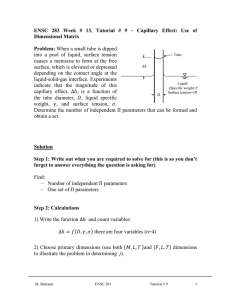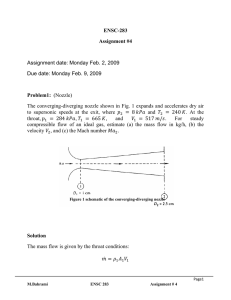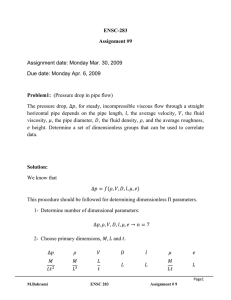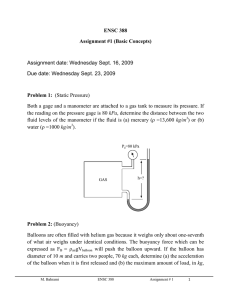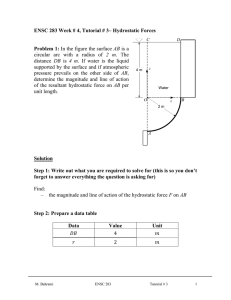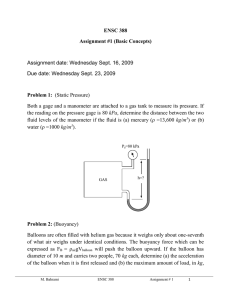ENSC 388 Assignment #3 Problem 1
advertisement
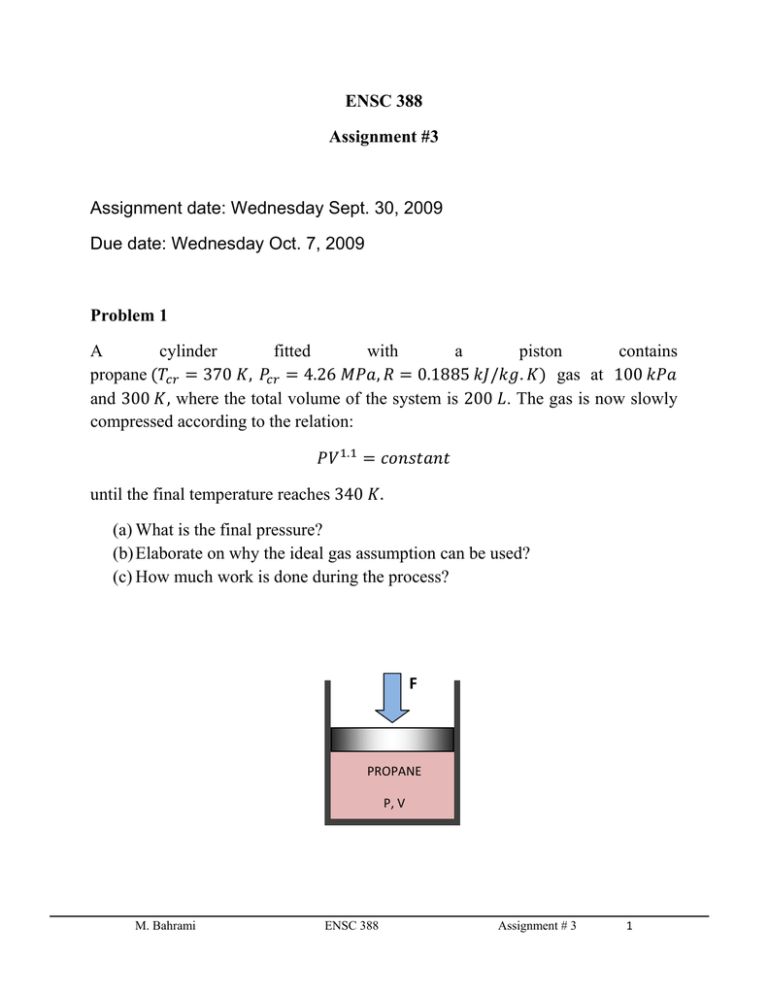
ENSC 388 Assignment #3 Assignment date: Wednesday Sept. 30, 2009 Due date: Wednesday Oct. 7, 2009 Problem 1 A cylinder fitted with a piston contains propane 370 , 4.26 , 0.1885 / . gas at 100 and 300 , where the total volume of the system is 200 . The gas is now slowly compressed according to the relation: . until the final temperature reaches 340 . (a) What is the final pressure? (b) Elaborate on why the ideal gas assumption can be used? (c) How much work is done during the process? F PROPANE P, V M. Bahrami ENSC 388 Assignment # 3 1 Problem 2 Water contained in a piston-cylinder assembly undergoes two processes in series from an initial state where the pressure is 10 and the temperature is 400 . Process 1-2: The water is cooled as it is compressed at constant pressure of 10 to the saturated vapour state. Process 2-3: The water is cooled at constant volume to 150 . (a) Sketch both processes on T-v and P-v diagrams. (b) For the overall process determine the work, in / . (c) For the overall process determine the heat transfer. W WATER Pi= 10 bar Ti= 400 ̊C Q M. Bahrami ENSC 388 Assignment # 3 2 Problem 1: Known: : 370 , 4.26 , 0.1885 / . : 100 , 300 , 200 Find: - Final pressure of the process. - The work is done during the process. Assumptions: - Weight of the pistons is negligible. - Equilibrium condition. - Propane is ideal gas Analysis: P F 2 F . . ` P1, V1 P2, V2 1 V State1 State2 M. Bahrami ENSC 388 Assignment # 3 3 From ideal gas assumption: 100 0.2 340 300 22.667 . 17.027 . Also, from compression process: . . 100 0.2 . . . Thus: . 17.027 22.667 . . . . 0.0572 From ideal gas equation of state: Applying ideal gas equation of state for state 1: 100 0.1885 0.2 . 300 0.345 Thus: 0.345 0.1885 . 340 0.0572 396.6 M. Bahrami ENSC 388 Assignment # 3 4 (b) Since pressures and temperatures are far from the critical state, the ideal gas equation of state can be used in this problem with no error. (c) Work in a close system is calculated from: can be related to . / with . 1 ( is constant): . 1.1 Substituting . . . 0.1 . 0.1 . . : . . . 0.1 0.1 Thus: 396.6 100 0.0572 0.2 0.1 26.5 M. Bahrami ENSC 388 Assignment # 3 5 Problem 2: Known: The : 10 , 400 Find: - Processes on T-v and P-v diagrams - Overall work and heat transfer Assumptions: - Weight of the pistons is negligible. - Equilibrium condition. Analysis: (a) Let us determine the three states of the process: State 1 ? 400 1000 2 Saturated Vapour 3 ? 150 M. Bahrami ENSC 388 Assignment # 3 6 State 1: 10 From Table A-5, superheated vapour. 400 : @ 1 400 179.88 Reading Table 400 at A-6 0.30661 . Thus state 1 is 1 and 2957.9 State 1 Super heated vapour 2 Saturated Vapour 3 ? 400 1000 0.30661 2957.9 1000 150 State 2: 1 Using Table A-5 for saturated vapour at 0.19436 : 2582.8 State 1 Super heated vapour 400 1000 0.30661 2957.9 1000 0.19436 2582.8 2 Saturated Vapour 179.88 3 ? 150 0.19436 M. Bahrami ENSC 388 Assignment # 3 7 State 3: Process 2-3 is Reading Table A- 4: constant volume, 0.001091 @ 0.19436 hence 0.19436 @ / . 0.39248 As a result, state 3 is saturated mixture and: 0.19436 0.001091 0.494 0.001091 0.39248 @ @ 631.66 0.494 1927.4 1584.1 State 1 Super heated vapour 400 1000 0.30661 2957.9 2 Saturated Vapour 179.88 1000 0.19436 2582.8 3 Saturated Mixture 150 476.16 0.19436 1584.1 M. Bahrami ENSC 388 Assignment # 3 8 T-v and P-v diagrams are: P1= P2=10 bar T P P3 1 10 bar P3 2 2 1 179.9 ̊C 150 ̊C 3 3 v v (b) The overall process work is: Since process 1-2 is constant pressure and process 2-3 is constant volume 0 : or per unit mass: 1000 0.19436 0.30661 112.2 (c) Applying the first law of thermodynamics: M. Bahrami ENSC 388 Assignment # 3 9 ∆ 1584.1 ∆ 2957.9 112.2 1485.4 Note (1): Since the deviation of gas from ideal gas behaviour is greatest in the vicinity of the critical point, when pressure and temperature are far from this point, ideal gas assumption can be used without any essential error. Note (2): At very low pressures gases behave as an ideal gas regardless of temperature Note (3): At high temperatures, ideal gas behaviour can be assumed with good accuracy regardless of pressure (except for ). M. Bahrami ENSC 388 Assignment # 3 10
